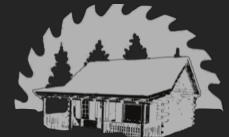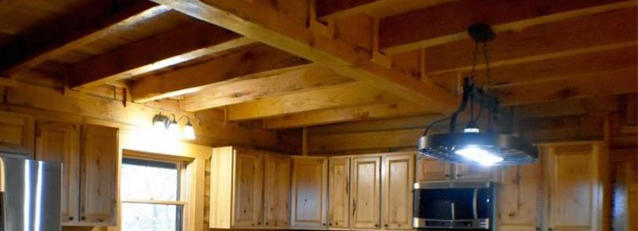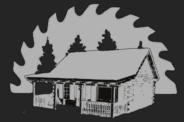




Energy Efficiency






National Bureau Of Standards Tests Confirm Energy-Conserving "Thermal Mass
Effect" For Heavy (Log) Walls In Residential Construction
Summary of Test Findings
A study was conducted by the National Bureau of Standards (NBS) for the
Department of Housing and Urban Development (HUD) and the Department of
Energy (DOE) to determine the effects of thermal mass (the bulk of solid wood log
walls, or brick and block walls) on a building's energy consumption. For the test, six
20'x20' test buildings were built on the grounds of the National Bureau of Standards,
20 miles north of Washington, DC, in the fall of 1980. Each structure was identical
except for construction of its exterior walls. The buildings were maintained at the
same temperature levels throughout the 28week test period between 1981 and
1982. NBS technicians precisely recorded energy consumption of each structure
during this entire period.
Test Results
• During the three-week spring heating period, the log building used 46% less
heating energy than the insulated wood frame building.
• During the eleven-week summer cooling period, the log building used 24%
less cooling energy than the insulated wood frame building.
• During the fourteen-week winter heating period, the log building and the
insulated wood frame building used virtually the same amounts of heating energy.
The National Bureau of Standards technicians conducting the test calculated the R-
value of the log building, which was constructed with a 7" solid square log, at a
nominal R-10. It rates the insulated wood frame building, with its 2'x4' wall and 3-1/2"
of fiberglass insulation, at a nominal R-12, thus giving the wood frame structure a
17% higher Rvalue. Yet during the entire 28 week, three season test cycle, both
buildings used virtually identical amounts of energy. This led the National Bureau of
Standards to conclude that the thermal mass of log
walls is an energy-conserving feature in residential construction.
NBS Tests Confirm Energy-Conserving "Thermal Mass Effect" of Log Walls
Full Report
In the first extensive field testing of its kind, researchers at the Commerce
Department's National Bureau of Standards (NBS) have confirmed that walls of
heavyweight construction (such as those built with solid wood logs, concrete block or
brick) exhibit an energy conserving "mass effect" in residential buildings during the
summer and the intermediate heating season representative of fall or spring in a
moderate climate. However, no mass effect was observed during the winter heating
season.
According to NBS researchers, these extensive field tests should help resolve a
controversy over whether residences having heavyweight walls consume less
energy for space heating and cooling than buildings having lightweight walls of
equivalent thermal resistance.
The National Bureau of Standards research team found that the heavyweight walls
(including building number 5, the log structure) "did exhibit a thermal mass effect and
thus save significant amounts of energy both in the summer cooling season and the
intermediate heating season representative of fall or spring in this (Washington, DC)
area."
The Use of R-Values
Most state and local building codes require specific "R-Values," or thermal resistance
values, for the walls, ceilings, and floors of houses. The R-Values in these codes
vary with geographical location and climate considerations. The Building Systems
Councils' technical staff and other industry professionals have often challenged the
exclusive reliance on R-Values alone to rate the energy efficiency of a wall's building
materials while ignoring the thermal mass effect inherent in heavyweight (log) walls.
R-Values are recognized by most professionals to be a reliable indication of the
thermal performance of a material--under conditions of constant interior and exterior
temperatures. The Building Systems Councils' technical staff argues that these are
not the conditions that exist in the "real world," where outdoor temperatures vary
widely during a typical day-night cycle. To
obtain a true rating of building's thermal efficiency in these conditions, building codes
must also consider the "mass effect" of heavyweight (log) walls.
What Is "Mass Effect"?
According to NBS researchers, "the mass effect relates to the phenomenon in which
heat transfer through the walls of a building is delayed by the high heat (retention)
capacity of the wall mass. Consequently, the demand for heating or cooling energy
to maintain indoor temperature may, under some circumstances, be pushed back
until a time when wall heat transfer and equipment operating conditions are most
favorable." This heat retention phenomenon is also referred to as "thermal
capacitance" or time lag--the resistance of a material (such as solid wood walls) over
time to allow a change in temperature to go from one side to the other.
How Mass Saves Energy
NBS researchers explained the energy saving effect of mass during the summer
cooling season this way: "In an insulated wood frame building, which is considered
to have low mass, the maximum wall heat gain rate during this season is operating
most often and working the hardest. In a heavy walled building (such as the log
building), however, the heat transfer lag means the maximum wall heat gain rate
general during the cool night period when the cooling plant is operating least often or
not at all. Consequently, the cooling energy requirement is reduced."
The NBS test showed that the log structure performed better than the insulated
wood building in the intermediate heating season and the summer cooling season;
however, there was no appreciable difference during the winter heating season.
During the winter heating season, no effect of mass was noted since all insulated
buildings and the log building required comparable amounts of heating energy each
hour to maintain their predetermined indoor temperatures.
Test Limitations
As with all such test procedures, these tests have their own limitations, according to
NBS, and therefore these factors should be considered in using the results. The
structures had no partition walls or furniture; items which would tend to give the
wood frame structures some of the mass effect. Also, the buildings were closed at all
times, and the buildings were constructed to maximize the mass effect
attributable to the walls.
• Also, the results are very climate dependent, and results relate to the moderate
climate found in the Washington, DC, area.
Future Tests
Future tests to be carried out on the six buildings will address some of these
limitations by installing partition walls and opening windows when appropriate.
Moreover, a recently developed NBS computer model that predicts the energy
consumption for multi-room structures will be validated and subsequently used to
extend the NBS test results to other locations and climates around the country.
Conclusion
The Building Systems Councils is gratified that its long struggle to gain recognition
for the importance of "thermal-mass" has been confirmed by these tests and that the
energy efficiency of log homes has been proven. The Council is presently
participating in a similar testing program being conducted by the Oak Ridge National
Testing Laboratory in Albuquerque, New Mexico, and hopes to add the results of
those tests to this material in an effort to gain acceptance of "thermal mass effect" in
building codes throughout the country. We further await the results of future tests to
be performed by the NBS at this test site and the results of the NBS computer-
modeling program.
A complete technical presentation of this study was prepared by D.M. Burch, W.E.
Remmert, D.F. Krintz, and C.S. Barnes of the National Bureau of Standards,
Washington, DC, in June, 1982, and is entitled "A Field Study of the Effect on Wall
Mass on the Heating and Cooling Loads of Residential Buildings." This study was
presented before the "Thermal Mass Effects in Buildings" seminar held in Knoxville,
Tennessee, on June 2-3, 1982, Oakridge National Laboratory, Oakridge, Tennessee.

Schutt Log Homes
& Mill Works



Energy Efficiency




National Bureau Of Standards Tests Confirm Energy-Conserving "Thermal Mass
Effect" For Heavy (Log) Walls In Residential Construction
Summary of Test Findings
A study was conducted by the National Bureau of Standards (NBS) for the
Department of Housing and Urban Development (HUD) and the Department of
Energy (DOE) to determine the effects of thermal mass (the bulk of solid wood log
walls, or brick and block walls) on a building's energy consumption. For the test, six
20'x20' test buildings were built on the grounds of the National Bureau of Standards,
20 miles north of Washington, DC, in the fall of 1980. Each structure was identical
except for construction of its exterior walls. The buildings were maintained at the
same temperature levels throughout the 28week test period between 1981 and
1982. NBS technicians precisely recorded energy consumption of each structure
during this entire period.
Test Results
• During the three-week spring heating period, the log building used 46% less
heating energy than the insulated wood frame building.
• During the eleven-week summer cooling period, the log building used 24%
less cooling energy than the insulated wood frame building.
• During the fourteen-week winter heating period, the log building and the
insulated wood frame building used virtually the same amounts of heating energy.
The National Bureau of Standards technicians conducting the test calculated the R-
value of the log building, which was constructed with a 7" solid square log, at a
nominal R-10. It rates the insulated wood frame building, with its 2'x4' wall and 3-1/2"
of fiberglass insulation, at a nominal R-12, thus giving the wood frame structure a
17% higher Rvalue. Yet during the entire 28 week, three season test cycle, both
buildings used virtually identical amounts of energy. This led the National Bureau of
Standards to conclude that the thermal mass of log
walls is an energy-conserving feature in residential construction.
NBS Tests Confirm Energy-Conserving "Thermal Mass Effect" of Log Walls
Full Report
In the first extensive field testing of its kind, researchers at the Commerce
Department's National Bureau of Standards (NBS) have confirmed that walls of
heavyweight construction (such as those built with solid wood logs, concrete block or
brick) exhibit an energy conserving "mass effect" in residential buildings during the
summer and the intermediate heating season representative of fall or spring in a
moderate climate. However, no mass effect was observed during the winter heating
season.
According to NBS researchers, these extensive field tests should help resolve a
controversy over whether residences having heavyweight walls consume less
energy for space heating and cooling than buildings having lightweight walls of
equivalent thermal resistance.
The National Bureau of Standards research team found that the heavyweight walls
(including building number 5, the log structure) "did exhibit a thermal mass effect and
thus save significant amounts of energy both in the summer cooling season and the
intermediate heating season representative of fall or spring in this (Washington, DC)
area."
The Use of R-Values
Most state and local building codes require specific "R-Values," or thermal resistance
values, for the walls, ceilings, and floors of houses. The R-Values in these codes
vary with geographical location and climate considerations. The Building Systems
Councils' technical staff and other industry professionals have often challenged the
exclusive reliance on R-Values alone to rate the energy efficiency of a wall's building
materials while ignoring the thermal mass effect inherent in heavyweight (log) walls.
R-Values are recognized by most professionals to be a reliable indication of the
thermal performance of a material--under conditions of constant interior and exterior
temperatures. The Building Systems Councils' technical staff argues that these are
not the conditions that exist in the "real world," where outdoor temperatures vary
widely during a typical day-night cycle. To
obtain a true rating of building's thermal efficiency in these conditions, building codes
must also consider the "mass effect" of heavyweight (log) walls.
What Is "Mass Effect"?
According to NBS researchers, "the mass effect relates to the phenomenon in which
heat transfer through the walls of a building is delayed by the high heat (retention)
capacity of the wall mass. Consequently, the demand for heating or cooling energy
to maintain indoor temperature may, under some circumstances, be pushed back
until a time when wall heat transfer and equipment operating conditions are most
favorable." This heat retention phenomenon is also referred to as "thermal
capacitance" or time lag--the resistance of a material (such as solid wood walls) over
time to allow a change in temperature to go from one side to the other.
How Mass Saves Energy
NBS researchers explained the energy saving effect of mass during the summer
cooling season this way: "In an insulated wood frame building, which is considered
to have low mass, the maximum wall heat gain rate during this season is operating
most often and working the hardest. In a heavy walled building (such as the log
building), however, the heat transfer lag means the maximum wall heat gain rate
general during the cool night period when the cooling plant is operating least often or
not at all. Consequently, the cooling energy requirement is reduced."
The NBS test showed that the log structure performed better than the insulated
wood building in the intermediate heating season and the summer cooling season;
however, there was no appreciable difference during the winter heating season.
During the winter heating season, no effect of mass was noted since all insulated
buildings and the log building required comparable amounts of heating energy each
hour to maintain their predetermined indoor temperatures.
Test Limitations
As with all such test procedures, these tests have their own limitations, according to
NBS, and therefore these factors should be considered in using the results. The
structures had no partition walls or furniture; items which would tend to give the
wood frame structures some of the mass effect. Also, the buildings were closed at all
times, and the buildings were constructed to maximize the mass effect
attributable to the walls.
• Also, the results are very climate dependent, and results relate to the moderate
climate found in the Washington, DC, area.
Future Tests
Future tests to be carried out on the six buildings will address some of these
limitations by installing partition walls and opening windows when appropriate.
Moreover, a recently developed NBS computer model that predicts the energy
consumption for multi-room structures will be validated and subsequently used to
extend the NBS test results to other locations and climates around the country.
Conclusion
The Building Systems Councils is gratified that its long struggle to gain recognition
for the importance of "thermal-mass" has been confirmed by these tests and that the
energy efficiency of log homes has been proven. The Council is presently
participating in a similar testing program being conducted by the Oak Ridge National
Testing Laboratory in Albuquerque, New Mexico, and hopes to add the results of
those tests to this material in an effort to gain acceptance of "thermal mass effect" in
building codes throughout the country. We further await the results of future tests to
be performed by the NBS at this test site and the results of the NBS computer-
modeling program.
A complete technical presentation of this study was prepared by D.M. Burch, W.E.
Remmert, D.F. Krintz, and C.S. Barnes of the National Bureau of Standards,
Washington, DC, in June, 1982, and is entitled "A Field Study of the Effect on Wall
Mass on the Heating and Cooling Loads of Residential Buildings." This study was
presented before the "Thermal Mass Effects in Buildings" seminar held in Knoxville,
Tennessee, on June 2-3, 1982, Oakridge National Laboratory, Oakridge, Tennessee.

Schutt Log Homes
& Mill Works




